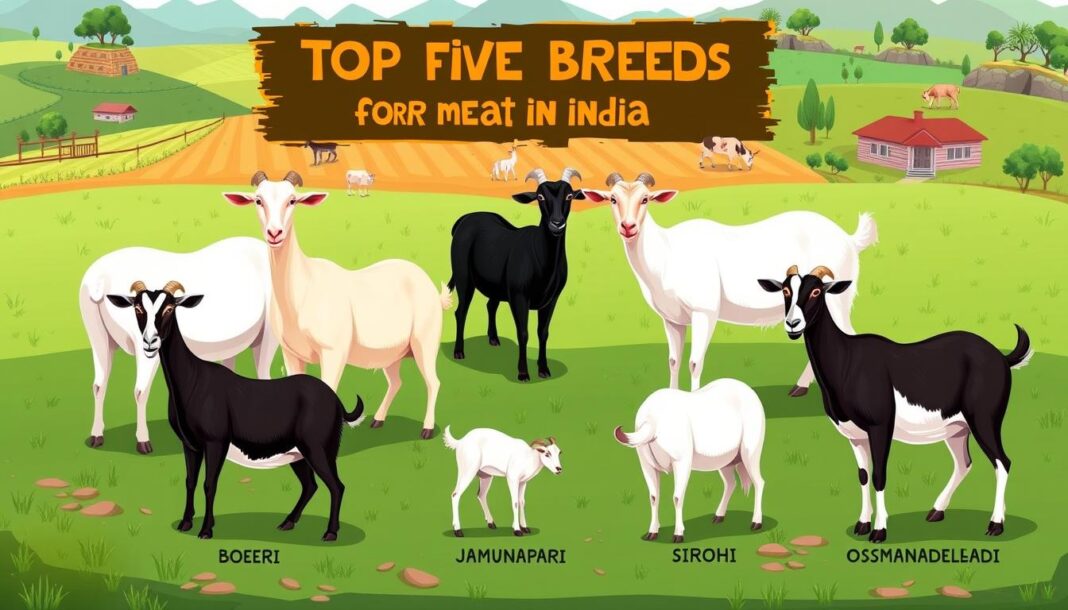Toned Milk vs Cow Milk
I’ve always been curious about the different milks out there. Growing up, cow’s milk was familiar to me. But now, toned milk has caught my eye. What makes these milks different, and which one is better for me? Let’s look into the world of toned milk and cow milk.
Milk is a common item in many homes, but it comes in many types. Cow milk has been popular for a long time. But toned milk, mainly found in India and Southeast Asia, is becoming more popular. Knowing the differences between these milks can help you pick the right one for you.
We’ll explore the unique aspects of toned milk and cow milk. We’ll look at how they’re made and their nutritional values. By the end, you’ll know which milk is best for you. Whether you want a healthier option, to manage your weight, or just enjoy cooking, you’ll be ready.
Understanding Milk Varieties
The dairy aisle is full of different milk options. Each has its own nutritional profile. From whole milk’s creamy richness to skimmed milk’s lightness, there’s a wide range to choose from.
Types of Milk Available
Whole milk is the most common, with about 3.25% milkfat and 150 calories in an 8-ounce serving. Toned milk has 3% fat, and double-toned has 1.5%. Skimmed milk has the least fat, with 0.5% and 80 calories in an 8-ounce glass.
There are also specialty milks like organic milk and lactose-free milk. These offer special benefits for different dietary needs and preferences.
Nutritional Profiles of Different Milk Types
Milk is packed with important nutrients like protein, calcium, and vitamins. Even though fat and calorie content vary, all milks have 13 essential nutrients. For example, reduced-fat milk (2%) has 5 grams of fat but the same 13 nutrients as whole milk.
Choosing between cow milk and toned milk depends on your diet and taste. Knowing the nutritional profiles of different milks helps you make choices that fit your health and wellness goals.
Toned Milk vs Cow Milk: A Closer Look
Toned milk and cow milk are very similar in what they offer nutritionally. Toned milk is made by mixing full-fat buffalo milk with skim milk and water. This makes it have less fat but keeps the important nutrients like calcium and B vitamins.
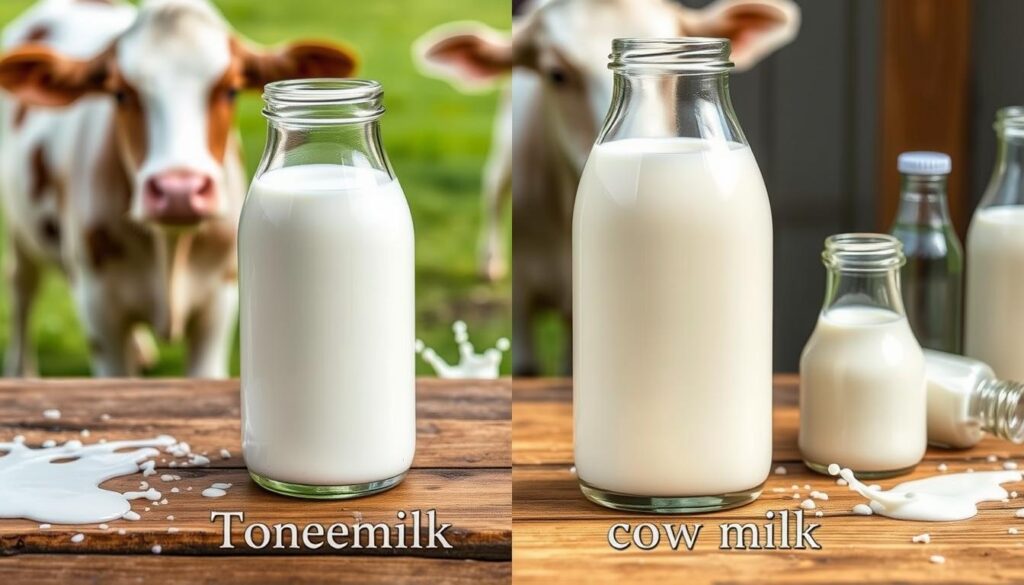
It’s like whole cow’s milk but with a bit less fat and more water. This makes it a good choice for those looking for a healthier option.
Looking at the numbers, toned milk has about 3ml of fat per 100ml. Cow milk has around 4% fat. A 100-milliliter serving of toned milk has 59 kcal, 4.7 grams of carbs, 3.1 grams of fat, and 3.1 grams of proteins.
It also has 23.1μg of Vitamin and 127mg of Calcium. Whole cow’s milk has 61 calories, 5 grams of carbs, 3 grams of protein, and 3 grams of fat.
Toned milk is a better choice for those who want less fat but don’t want to lose out on nutrients. It’s a healthier option compared to full-fat buffalo milk.
Toned milk consumption can aid in weight management because of its lower fat content.
There’s also double-toned milk, which has even less fat, about 1.5% total fat. It has 3.2 grams of protein and 47.5 calories per 100-milliliter serving. This makes it great for those on a low-calorie diet or watching their fat intake.
The Indian dairy market offers a range of milk options. This lets consumers choose the milk that fits their nutritional needs and preferences. Whether it’s lower fat, higher protein, or a balanced mix, there’s something for everyone.
Production Processes
How Toned Milk is Made
Toned milk is mainly made in India and Southeast Asia. It’s created by mixing full-cream buffalo milk with skim milk and water. This method was designed to boost the nutritional value of buffalo milk.
By adding skim milk and water, the fat content goes down. But, the levels of calcium and protein stay the same. This makes toned milk similar to whole cow’s milk but with less fat.

The toned milk processing involves a few steps:
- First, the full-cream buffalo milk is split into skim milk and cream.
- Then, the skim milk and cream are mixed together in the right amounts for the fat level.
- Water is added to thin out the fat and increase the milk supply.
- Lastly, the toned milk is pasteurized to keep it safe and fresh longer.
This method helps use milk efficiently. It makes toned milk cheaper and easier to get. It also keeps the important nutrients in.
Nutritional Comparison
Protein, Calcium, and Vitamin Content
Toned milk and whole cow’s milk are very similar in nutrients. They have almost the same calories, fat, and protein. A 3.5-ounce (100 ml) serving of whole cow’s milk has 61 calories, 3 grams of protein, and 3 grams of fat. Toned milk has 58 calories, 3 grams of protein, and 4 grams of fat.
Both are full of important nutrients like calcium, potassium, and B vitamins. They offer a balanced mix of nutrients.
Fat and Calorie Differences
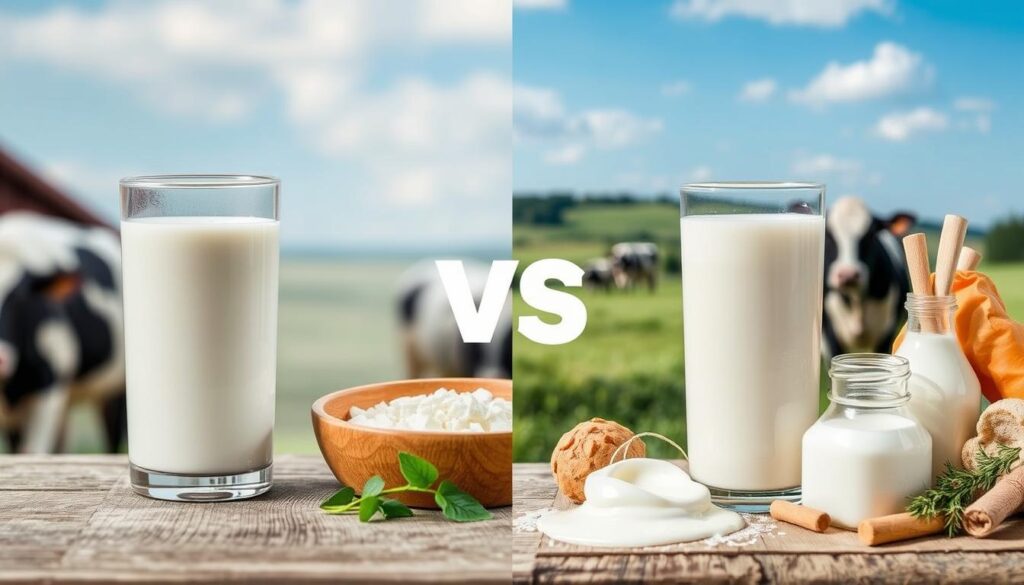
The main difference is in fat and calories. Toned milk has less fat and calories. It’s better for those watching their weight or saturated fat intake.
Toned milk has about half the calories of whole milk. It’s a good choice for a balanced diet and overall health.
| Nutritional Content | Whole Cow’s Milk | Toned Milk |
|---|---|---|
| Calories (per 3.5 oz/100 ml) | 61 | 58 |
| Carbohydrates (g) | 5 | 5 |
| Protein (g) | 3 | 3 |
| Fat (g) | 3 | 4 |
The table shows the main differences between whole cow’s milk and toned milk. Toned milk has fewer calories and fat but similar protein. This makes it a good choice for a healthier milk option.
Health Benefits and Considerations
Advantages of Low-Fat Toned Milk
Toned milk is a healthy choice that brings many benefits. It’s good for your bones and can lower the risk of heart disease and type 2 diabetes.
Its lower fat content is great for those trying to lose weight. It has fewer calories but keeps the important nutrients. It’s also better for people with lactose intolerance or sensitive stomachs.
But, toned milk is not for everyone. If you have a dairy allergy or intolerance, it’s best to avoid it. People with these issues might prefer plant-based milk alternatives instead.
| Milk Type | Fat Content | Calories per Glass (approx.) |
|---|---|---|
| Full-Cream Milk | 3.5% | 160 |
| Toned Milk | 3% | 80 |
| Double Toned Milk | 2.7% | 72 |
| Skimmed Milk | 0.1% | 90 |
Choosing the Right Milk for Your Dietary Needs
Choosing between cow milk and toned milk depends on what you need and like. Cow milk has more calories and fat, making it great for kids, athletes, or those trying to gain weight healthily. Its creamy texture and rich taste are also perfect for cooking.
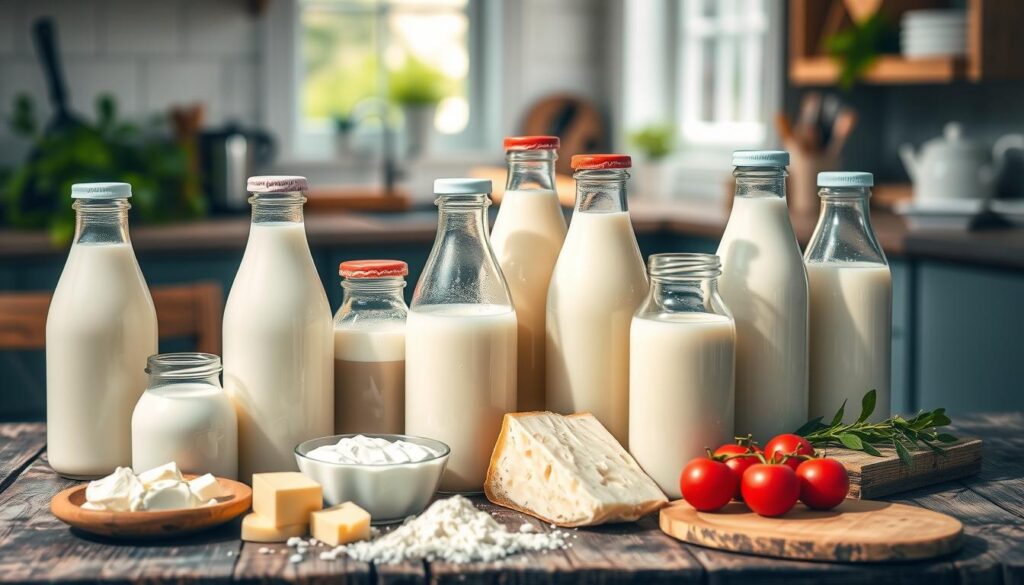
Toned milk, with about 3% fat, is good for those watching their weight or dealing with lactose intolerance. It’s also great for malnourished people, pregnant women, and those who care about their health. Double-toned milk, with just 1.5% fat, is ideal for keeping your heart healthy and managing your weight.
| Milk Variety | Fat Content | Suitable For |
|---|---|---|
| Cow Milk | Over 3.5% | Children, pregnant women, weight gain |
| Toned Milk | 3% | Malnourished, pregnant women, weight management |
| Double Toned Milk | 1.5% | Weight management, heart health |
Choosing the right milk depends on your nutritional needs, health, and taste. Always talk to a doctor or dietitian to find the best milk for you.
Culinary Applications
Choosing between toned milk and cow milk can change how your dishes turn out. Cow milk is great for rich desserts, creamy sauces, and thick drinks like milkshakes. Its creamy texture and rich flavor are perfect for these treats.
Toned milk, on the other hand, is great for everyday cooking and baking. It has less fat but keeps the nutritional value high. It’s perfect for recipes where you want a lighter touch without losing flavor. This makes it a healthier option for those watching their fat and calorie intake.
When to Use Toned Milk vs. Cow Milk

- Baking and Cooking: Toned milk is perfect for everyday dishes because it keeps things light and fluffy.
- Creamy Sauces and Desserts: Cow milk is better for creamy sauces and rich desserts. It adds a richer taste and texture.
- Beverages: Cow milk is best for drinks like milkshakes and hot cocoa. It gives them a creamier taste.
- Lactose Intolerance: People with lactose intolerance might find toned milk easier to digest because it has less lactose.
Knowing the differences between toned milk and cow milk helps both home cooks and chefs. It lets them choose the right milk for the best flavor, texture, and nutrition in their dishes.
Lactose Intolerance and Plant-Based Alternatives
For those with lactose intolerance or who prefer not to drink dairy, there are many plant-based milk alternatives available. Options like soy milk, almond milk, and oat milk offer a creamy feel and nutrients similar to cow milk. They don’t have lactose, making them a good choice.
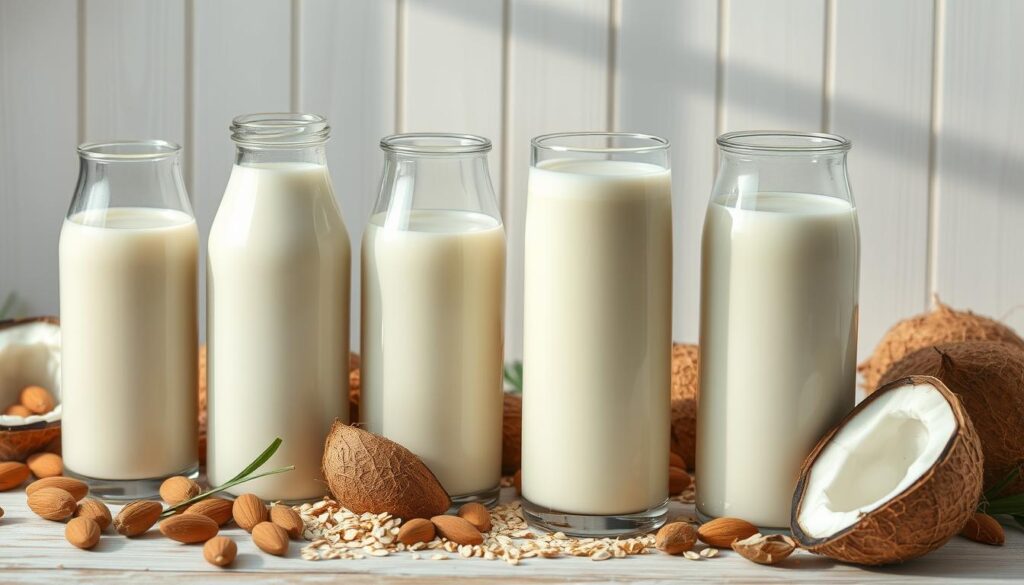
These plant-based milk alternatives work well in many recipes and as everyday drinks. But, it’s key to check the nutrition facts and choose what fits your diet best.
| Milk Type | Calories (per cup) | Fat (g) | Protein (g) | Carbs (g) | Fiber (g) |
|---|---|---|---|---|---|
| Cow’s Milk (1%) | 110 | 2.5 | 8 | 12 | 0 |
| Soy Milk | 110 | 4.5 | 8 | 9 | 2 |
| Almond Milk | 45 | 4.5 | 1 | 1 | 1 |
| Oat Milk | 120 | 5 | 2 | 6 | 2 |
Exploring these plant-based milk alternatives can help those with lactose intolerance or who want dairy-free choices. They offer tasty and healthy options that meet dietary needs and preferences.
Conclusion
Choosing between toned milk and cow milk depends on your diet, health, and taste. Toned milk has less fat but keeps important nutrients like protein and calcium. Cow milk, on the other hand, is creamier and richer, perfect for some recipes.
Knowing the nutritional differences and how each is made helps you decide. Consider your lactose tolerance and if you prefer non-dairy options. These factors are important when picking the right milk for you.
It’s vital to eat a balanced diet and not overdo it, no matter the milk type. By learning about the dairy industry and the different milks, you can choose wisely. This leads to better health and a more enjoyable cooking experience.



